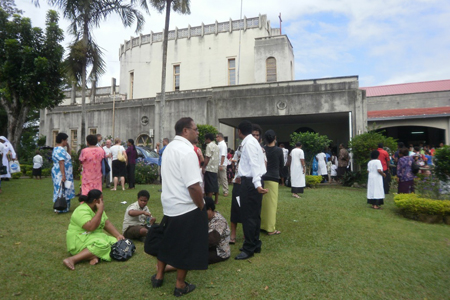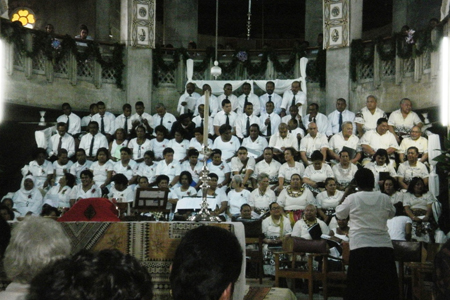| |
 |
 |
 |
| Comment on this report, or find other reports. |
 |
| Our Mystery Worshippers are volunteers who warm church pews for us around the world. If you'd like to become a Mystery Worshipper, start here. |
 |
| Find out how to reproduce this report in your church magazine or website. |
|
|
| 2037: Holy Trinity Cathedral, Suva, Fiji Islands |
 |
 |
 |
Mystery Worshipper:
Tukai.
The church:
Holy Trinity Cathedral, Suva, Fiji Islands.
Denomination:
The Anglican
Church in Aotearoa, New Zealand and Polynesia, Diocese
of Polynesia.
The building:
A large concrete-block structure, visibly built in two stages.
The older eastern end, completed in 1952, is higher and has
an interior gallery and upper story windows. Offices block the
light and breeze on either side of the "choir." Tapa
cloths and banners in similar Pacific style are draped on the
columns as decoration. The western end, completed in 1974, is
styled more as a hall and used as such during the week. It has
a row of wide doors on either side, all of which open to let
the breeze through, which is very necessary in the tropical
humidity.
The church:
The congregation is one of the most multi-cultural in Suva.
It includes not only iTaukei (indigenous Fijians), but also
Indo-Fijians, resident "Europeans" (meaning anyone
of Caucasian appearance), Fijians of Solomoni descent (whose
ancestors were taken in the 1860s from the Solomon Islands to
work on colonial plantations), university students from the
Solomon Islands and Vanuatu, plus a smattering of other Pacific
islanders. For this special occasion, not only did people of
all these types come from other parts of Fiji, but also substantial
contingents from Tonga and New Zealand, including no fewer than
eight visiting bishops and two archbishops.
The neighbourhood:
The Republic of the Fiji Islands comprises an archipelago of
more than 332 islands, of which 110 are permanently inhabited,
and more than 500 islets. Suva, on the island of Viti Levu,
is Fiji's capital. It is a beautiful city, blending the modern
with colonial architecture. Holy Trinity is on the edge of Suva's
downtown area, and is just across the road from the main strip
of night clubs and bars.
The cast:
The Most Revd William Brown Turei, archbishop and primate of
the province of Tikanga Maori, presided at the installation
and celebrated the eucharist that followed. He was assisted
by the Most Revd David Moxon, archbishop and primate of the
province of Tikanga Pakeha. The preacher was Sepi Hala'api'api,
diocesan youth coordinator. The Very Revd Fereimi Cama, dean,
gave the opening remarks.
The date & time:
1 August 2010, 10.00am (and lasting until 12.50pm).
What was the name of the service?
The Installation of the Rt Revd Dr Winston Halapua as the sixth
Bishop of the Diocese of Polynesia, and recognition as an archbishop
of the Anglican Church in Aotearoa, New Zealand and Polynesia.
How full was the building?
Full to overflowing. Even with extra tiered seating installed
on scaffolding and with the normally unused upper gallery full,
there were hundreds on the verandahs on either side of the main
nave. The informal lunch afterward catered for 1700.
Did anyone welcome you personally?
Yes. My wife was known to the usher as someone who had been
associated with the centenary of the diocese in 2009, so we
were shown specially to some seats just behind the area reserved
for family.
Was your pew comfortable?
A standard Anglican pew, on which we sat without our backs complaining
for nearly three hours. So I guess they weren't too uncomfortable.
How would you describe the pre-service
atmosphere?
The church was half full when we got there one hour before the
start, and 95 per cent full 45 minutes before the start. This
is very unusual in the Pacific – but the start had been advertised
as "English time, not Fiji time." There was a buzz
of conversation as people greeted relatives and friends among
the many visitors and vice-versa. We had a rehearsal of a new
hymn, and then the choir sang a few hymns to get people in a
service mood.
What were the exact opening words of the
service?
After the opening procession, the dean said: "On behalf
of the diocese and the cathedral, I'd like to welcome you all
to this service." He then extended special greetings to
various people, starting with the archbishops.
What books did the congregation use during the
service?
There was a specially printed order of service, which included
the full text of the liturgy, hymns and readings. Although most
of the service was in English, the hymns were in several different
languages (English, Fijian, Hindi, Tongan and Samoan, to name
a few!), so there would have been very few present who knew
all the words without the printed order to help. In addition,
some words of the liturgy were printed in English but said in
Maori.
What musical instruments
were played?
An electronic organ opened each hymn, but after the opening
the organ was inaudible beneath the full-blooded and harmonious
singing by the large choir and congregation. The Fiji choir
was augmented for the occasion by a contingent of Tongans from
New Zealand, all under the direction of the Revd Tomu Asioli,
choirmaster. Just after the moment of installation, three conch
shells were played bugle-like from the gallery in rhythm with
the lali (slit drum) from the verandah.

Did anything distract
you?
I was amazed by a baby in the arms of his mother in the pew
in front of us, who managed to sleep through the very loud pre-service
and opening hymns, but later woke and cried a few times, not
least when he tugged at his own hair. I kept trying to count
how many bishops were assembled for the occasion, and to identify
the various notables, but they moved and got obscured, which
made it hard. There were photographers and TV cameramen moving
around as well.
Was the worship stiff-upper-lip, happy clappy, or
what?
No service led by two archbishops in full regalia could be called
informal, but it was without the full high-church trimmings
of incense, etc. The service included a variety of styles and
languages, especially the hymns as noted above. The Lord's Prayer
was said in Fijian, accompanied by 300 youths in white raiment
performing actions to match. They filled the aisle and the upstairs
gallery. At one point there was a Tongan procession, to the
sound of a single young cantor, who sang beautifully without
either accompaniment or microphone. Between the actual installation
and the eucharist, there were speeches of greeting and presentation
of gifts from various bishops and others representing both the
people of the diocese and other dioceses, the new bishop's family,
and representatives from parishes he had previously served.
Given that there were at least a dozen bishops present, it was
notable that the sermon was preached by a young laywoman. This
choice (presumably by Bishop Halapua himself) may carry a message
about the future direction of the diocese.
Exactly how long was the sermon?
15 minutes.
On a scale of 1-10, how
good was the preacher?
8 – Sepi Hala'api'api spoke confidently and was not overawed
by the occasion or by the hierarchy all around her. She pictured
the new bishop as the captain steering the waka (canoe) in the
direction set by Jesus as the compass, with the elders having
the experience to know when to cast the net to pull in the fish
(souls) and the youth having the strength and vigour to perform
this work.
In a nutshell, what was
the sermon about?
She noted that the youth representatives at the electoral synod
had asked for the election of someone with a list of virtues
so comprehensive that only Jesus Christ could have them all.
But Bishop Halapua still scored well against these criteria.
In the epistle (Colossians 3:1-11), St Paul emphasised that
despite our diversity in cultures, gender and age, we are all
one in Christ. This has to be central to our life and work in
the multicultural, multiracial diocese of Polynesia. The gospel
story of the rich fool (Luke 12:13-21) pointed to the dangers
of the modern "I-world" (in which I want an I-pod)
that is creeping even into Polynesia. We need to make following
Jesus more central to life than this sin of greed.
Which part of the service
was like being in heaven?
At first glance, Archbishop Brown Turei looked like a reincarnation
of the late Bishop Jabez Bryce (the previous bishop of Polynesia),
whose funeral I had attended earlier this year; this made me
wonder if we really were in heaven! Some of the more moving
parts of the service itself were: the sound of the conches from
high in the gallery; the luminous pride of the new bishop's
wife when she came forward to receive a gift on their behalf;
and Handel's Hallelujah Chorus in Tongan, which came
as an encore after the bishops had processed out.
And which part was like
being in... er... the other place?
The sound system squealed quite a few times during the service
– most commonly after one non-working travelling microphone
was replaced by another. Also, the person sitting next to me
talked non-stop for the hour leading up the service. (No, I
don't mean my wife!) Wriggling through the crowd to get back
from one of the communion stations was a bit tricky too, though
this was understandable in the circumstances.
What happened when you hung around after the service looking lost?
In such a good-spirited throng, it would have been difficult
not to get drawn into conversation with others, be they residents
or visitors. Among others I spoke with was a student from England,
who was in Fiji doing a sociology project on the role of religion
in Pacific society – she had certainly come to the right place
at the right time!
How would you describe the after-service
coffee?
Coffee – phooey! There was whole Pacific feast on offer, not
to mention tea, soft drink and kava. But the queue was long,
and in my state of health I needed a rest, so passed it by.
However, a friend who did stay on told me later that the lunch
and party lasted till at least 5.00 (when he left), and featured,
among other spontaneous entertainment, folk singing by the visiting
archbishop of Melanesia.
How would you feel about making this church your regular (where 10 = ecstatic, 0 = terminal)?
8 – Today's special service may not provide a good guide
to what a regular service might be like. I certainly would not
want to have a regular morning service that runs for nearly
three hours!
Did the service make you feel glad to be a
Christian?
My word, yes. Not least because it demonstrated the inclusivity,
brotherhood and lively youth of the church.
What one thing will you remember about all this in seven days' time?
The sound of the conch. |
|
|
 |
 |
 |
| We rely on voluntary donations to stay online. If you're a regular visitor to Ship of Fools, please consider supporting us. |
 |
 |
 |
| The Mystery Pilgrim |
 |
| One of our most seasoned reporters makes the Camino pilgrimage to Santiago de Compostela in Spain. Read here. |
 |
 |
 |
| London churches |
 |
| Read reports from 70 London churches, visited by a small army of Mystery Worshippers on one single Sunday. Read here. |
| |
|
|
|
|


